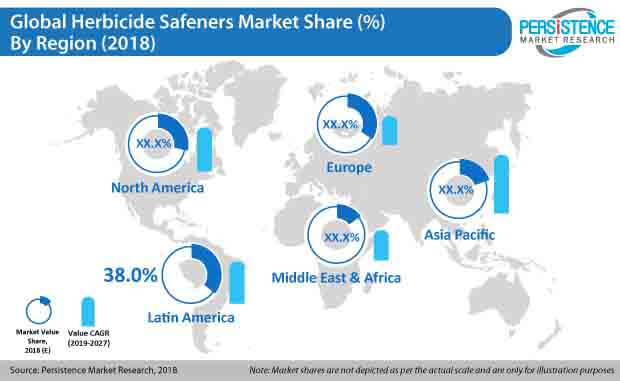Herbicide Safeners Market Segmented By Benoxacor, Furiazole, Dichlormid, Isoxodifen, Fluxofenim Type with Pre-Emergence, Post-Emergence in Barley, Maize, Rice, Sorghum, Soybeans, Wheat Crops
Industry: Food and Beverages
Published Date: January-2019
Format: PPT*, PDF, EXCEL
Delivery Timelines: Contact Sales
Number of Pages: 160
Report ID: PMRREP25219
Increasing developments and emerging technologies across the globe have changed the face of the agricultural sector. There has been an emergence of several markets in the agricultural sector, with the increasing demand for food being the prominent driver.
Reducing arable land and decreasing resources have increased the pressure on the supply-demand chain in the agricultural sector. This has led to the emergence of innovative crop protection products in order to secure agricultural produce. Changing climatic conditions and environmental status, as well as increasing emergence of various weeds and herbs have had a negative impact on the quality as well as yield of crops.
Thus, there has been an increase in the demand for several crop protection products such as herbicides and herbicide safeners.
Herbicide safeners are chemicals that are used as herbicide antidotes. Herbicide safener chemical agents increase the tolerance of cereal plants to herbicides without having an impact on their weed control ability. Herbicide safeners work by inducing certain genes in crops that increase the production of an enzyme that takes part in herbicide detoxification. Thus, herbicide safeners help protect crops from damage caused by herbicides.
The global herbicide safeners market is expected to create an attractive absolute dollar opportunity of around US$ 514.5 by 2027 over 2018. The benoxacor segment, under type, is expected to exhibit a high growth across segments in the global herbicide safeners market. Latin America is currently a prominent region, and is expected to have a high market share in the global herbicide safeners market over the forecast period.
However, Asia Pacific region is expected to grow at a high pace in the herbicide safeners market over the forecast period.
By type of herbicide safeners, the benoxacor segment is expected to a prominent segment as compared to the other types of herbicide safeners, owing to its increasing use in herbicides for soybean, corn, and sorghum.
By application stage of herbicide safeners, the pre emergence segment is expected to be a prominent segment in the global herbicide safeners market, with its increase in seed treatment as well as multiple benefits such as lesser hazards and ease in application.
By crops, the maize segment is expected to have a prominent share as compared to other crops in the global herbicide safeners market over the forecast period. Soybean is expected to be another crop that has a good absolute dollar opportunity in the global herbicide safeners market. The growing demand and production of soybean and maize in one of the factors having a positive effect on the global herbicide safeners.
The growing demand for crop protection and care products is one of the direct drivers for the herbicide safeners market. As the world’s population continues to grow, the amount of land available for food production is reducing. As such, the increasing attempts to achieve higher yield are proving to be an important driver of the global herbicide safeners market.
The increasing use of concentrated herbicides is having a negative impact on crop produce and quality, as herbicides damage the crops along with the weeds. Thus, herbicide safeners are increasingly gaining popularity. There has been an increase in the use of herbicide safeners for crops such as soybean, maize, rice, wheat, sorghum, and barley. The growing cultivation of these crops is proving to be one the major drivers for the global herbicide safeners market. The evolution of herbicide-resistant species has led to the development of newer and stronger herbicides, leading to the increased used herbicide safeners in order to protect crops.
Currently, herbicide safeners are effective just for monocot plants. The effectiveness of herbicide safeners on dicots is still unknown, and is a factor that is hindering the herbicide safeners market from reaching its full potential. Rising environmental safety concerns about the use of herbicides as well as strict regulations by governments in many countries are some of the factors that are restraining the market.

The global herbicide safeners market has been regionally segmented as North America, Latin America, Europe, Asia Pacific, and the Middle East & Africa. Latin America current holds a large share in the global herbicide safeners market. Latin America is expected to be a prominent region over the forecast period in the global herbicide safeners market.
North America follows Latin America in terms of value share in the global herbicide safeners market. Asia Pacific is expected to grow at a rapid pace with a high CAGR of about 8.5% from 2019-2027 in the global herbicide safeners market, owing to the increasing cultivation of wheat, rice, sorghum, and maize crops in the region. Europe is expected to show steady growth, being a mature market. The Middle East & Africa is expected to have a lower share as compared to other regions, owing to lesser agricultural activities in this region.
Thus, considering all the factors, the global herbicide safeners market is expected to grow positively in terms of value and volume over the forecast period.
The subsequent sections analyze the global herbicide safeners market on the basis of type, application stage, crops, and region, and presents a forecast for the period 2018–2027. The market is segmented as follows:
| Attribute | Details |
|---|---|
| by Type |
|
| by Application Stage |
|
| by Crops |
|
| by Region |
|
To know more about delivery timeline for this report Contact Sales
